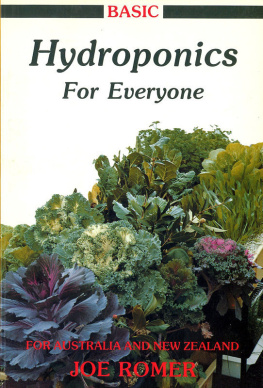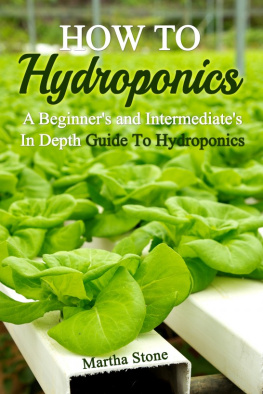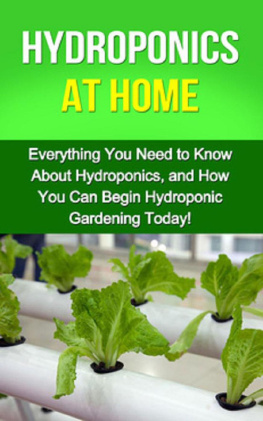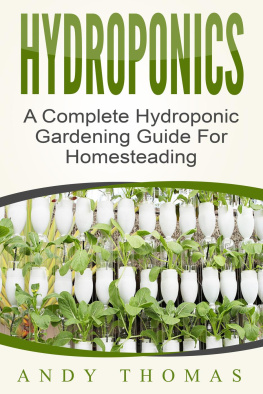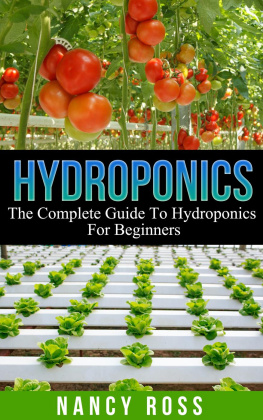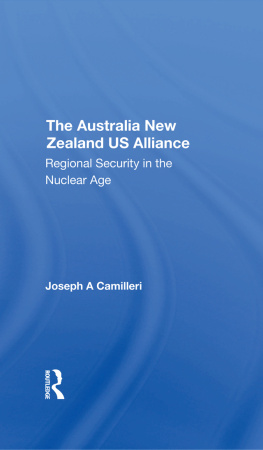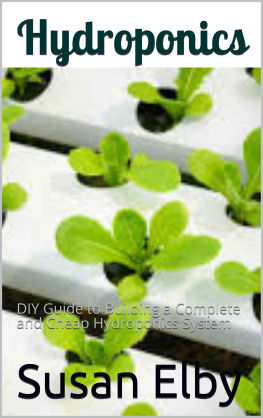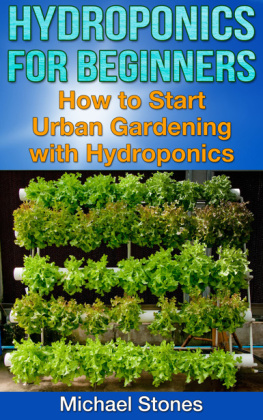Joe Romer - Basic hydroponics for everyone for Australia and New Zealand
Here you can read online Joe Romer - Basic hydroponics for everyone for Australia and New Zealand full text of the book (entire story) in english for free. Download pdf and epub, get meaning, cover and reviews about this ebook. City: Mt Colah, N.S.W, year: 1985, publisher: Shepp Books, genre: Children. Description of the work, (preface) as well as reviews are available. Best literature library LitArk.com created for fans of good reading and offers a wide selection of genres:
Romance novel
Science fiction
Adventure
Detective
Science
History
Home and family
Prose
Art
Politics
Computer
Non-fiction
Religion
Business
Children
Humor
Choose a favorite category and find really read worthwhile books. Enjoy immersion in the world of imagination, feel the emotions of the characters or learn something new for yourself, make an fascinating discovery.
Basic hydroponics for everyone for Australia and New Zealand: summary, description and annotation
We offer to read an annotation, description, summary or preface (depends on what the author of the book "Basic hydroponics for everyone for Australia and New Zealand" wrote himself). If you haven't found the necessary information about the book — write in the comments, we will try to find it.
Joe Romer: author's other books
Who wrote Basic hydroponics for everyone for Australia and New Zealand? Find out the surname, the name of the author of the book and a list of all author's works by series.
Basic hydroponics for everyone for Australia and New Zealand — read online for free the complete book (whole text) full work
Below is the text of the book, divided by pages. System saving the place of the last page read, allows you to conveniently read the book "Basic hydroponics for everyone for Australia and New Zealand" online for free, without having to search again every time where you left off. Put a bookmark, and you can go to the page where you finished reading at any time.
Font size:
Interval:
Bookmark:
For Australia and New Zealand
First Published 1985 Reprinted 1986
Reprinted 1987 Paperback Edition
Revised and updated 2012
All rights reserved. No part of this publication may be reproduced, stored in a retrieval system or transmitted in any form or by any means electronic, mechanical, photocopying, recording or otherwise, without the prior written permission of the author.
National Library of Australia Cataloguing-in-Publication Data
Romer, Joe
Basic Hydroponics for Everyone for Australia & New Zealand
Includes Index
ISBN 978 0 949250 05 8 (pbk)
978 1 922155 30 6 (ePub)
978 1 922155 31 3 (mobi)
1. Hydroponics. I. Title. 631.5'85
an overview
Hydroponics is simple not complex. Most textbooks on hydroponics make it sound very complex and difficult. Hydroponics is growing plants without soil. This means supplying the plants with all of its requirements for growth under more controlled conditions than is possible with soil. The plants requirements for growth include root moisture, good root aeration, the required nutrient salts and their availability in the correct proportions, and a stable root temperature.
Plant growth is no faster or better than with good soil. However, soil consists of rock particles (sand, basalt, etc.) of various sizes from coarse to very fine (colloids); organic matter such as twigs, leaves, and humus; water which may be free or bound up by the soil particles; and air between the soil particles; and salts. A chemical analysis of the water in the soils can tell you the amount of salts and the specific salts that can be can be available to the plant at any time. A more thorough analysis of the soil can tell you what could be available to plants, but it may not be available to the plant. Hydroponics gives the grower control over all the factors for plant growth even to the point of modifying the nutrients supplied at each stage of the plants growth. With hydroponics the grower can control root temperature, root aeration, the level of moisture, and the nutrients supplied to the plant.
The essential difference between hydroponics and soil is that soil has cation-exchange capacity, or in laymans terms the nutrient salts are bound up in the organic matter and may or may not be released to the plant when and as required.
The essential difference between hydroponic and organic gardening is that in hydroponics refined nutrient salts are used. These salts are the same basic salts which the plant would get from soil anyhow, except that they have been refined and purified in the same way as sugar, or natural herbal medicines. The organic gardener uses manures and composts made of decayed organic matter for fertiliser. Plants cannot use any organic matter until it has been broken down into the basic chemical salts. The release of nutrient salts from organic matter is unpredictable and haphazard. The supply of nutrient salts in hydroponics is immediate and controllable.
For many years the plant grower has concentrated on the plants requirements above the soil, such as humidity, temperature, light intensity, length of day, based on the fact that soil is a known factor. Hydroponics looks at the total requirements of the plant, and realises the vital importance of good root aeration, a stable pH, the correct plant nutrient requirements, a stable root temperature, and the moisture balance.
While most people think of hydroponics as a means of growing vegetables, cut flowers, etc, it can be used to grow indoor plants.
For those people who prefer luxuriant healthy indoor plants that require watering every week or two, or in some cases three, there is available hydroculture, the application of hydroponics to indoor plants. The most difficult part about indoor plant care, once you have got the light right, is knowing when to water your plants. With hydroculture it is simple, when the saucer or nutrient reservoir is dry then top up with fresh water or diluted nutrient solution.
A major difference between soil and hydroponics is that if at any stage there is a problem in hydroponics the whole system can be flushed out with fresh water and it reverts back to its original situation. This is not easy to do with soil because the excess salts are bound up with the organic components. The flushing will remove any excess salt buildup, and clean out the whole system.
Space technology has taken hydroponics from fiction to fact. However, the practice of hydroponics is not new. It has been practiced for centuries in various forms, but it is only in the past fifty years that major strides have been taken and it has become a commercial proposition. The major breakthrough has been in our knowledge of the specific requirements of plants, a better understanding of plant growth factors and physiology, and the availability of more refined nutrient salts.
As early as 1699 an Englishman named Woodward proved that plants could be grown in water by dissolving soil in it. Nicholas De Saussure in 1804 theorised that plants were made up of water, soil, and air. Boussengault proved this theory by growing plants in sand and feeding them on various chemical salt solutions. In 1940 Robert B. and Alice Woodrow developed nutriculture and coupled with the need during the Second World War to grow fresh vegetables for the troops stationed in areas not suitable for normal agriculture gave hydroponics a new impetus. One of the first large installations was on Ascension Island in the South Pacific. They used a gravel media with the nutrient solution pumped through the bed on a preset cycle.
The first account of the nutrient film technique appeared in a scientific journal in 1975 using plants grown between two layers of plastic sheet.
The building of Israel into a nation is in part due to the use of hydroponics.
Any books on hydroponics generally reflected the country of originAmerican writers tended to favour sub irrigated gravel culture. English writers favoured the nutrient film technique (N.F.T.); and European writers favoured gravel culture. In Australia, the majority of authors, who tend to be academics, favoured the nutrient film system. Each system has advantages and disadvantages. Gravel culture and sub irrigated gravel culture are the simplest and easiest to control. The nutrient film technique is more sophisticated and looks deceptively easy. The N.F.T. system was widely used commercially in the U.K. but has had disastrous results in Australia in the early days. The author believes the reason for the success of N.F.T. in the U.K. was that it is used under environmentally controlled conditions for growing tomatoes. The price of tomatoes in the U.K. is very high and hence it pays to use environmentally controlled conditions, whereas the price of tomatoes in Australia is much lower and such growing conditions are not justified. Without these conditions it is very difficult to control the temperature of the nutrient film and our day temperatures are much higher than in the U.K and a lot more variable.
A hydroponic garden can give high crop yields from a very small space without backbreaking labour. There is less work because there is no soil to dig, no weeds to control, no soil borne pests, and there is greater control over the plant feeding. High yields are possible because the plants do not have to compete with the weeds for the available nutrient, and their roots do not have to search for water or feed because it is available to them, and plants can be grown closer together.
Hydroponics is simple and does not require expensive pumps, timers, or control equipment. It can be as simple as growing lettuce using a sheet of polystyrene floating on the nutrient solution or using a small tray filled with perlite and vermiculite mixture and feeding the plants every three to five days using a watering can.
Font size:
Interval:
Bookmark:
Similar books «Basic hydroponics for everyone for Australia and New Zealand»
Look at similar books to Basic hydroponics for everyone for Australia and New Zealand. We have selected literature similar in name and meaning in the hope of providing readers with more options to find new, interesting, not yet read works.
Discussion, reviews of the book Basic hydroponics for everyone for Australia and New Zealand and just readers' own opinions. Leave your comments, write what you think about the work, its meaning or the main characters. Specify what exactly you liked and what you didn't like, and why you think so.

